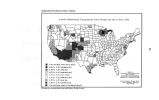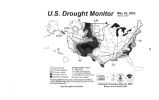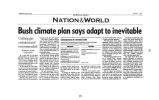| OCR Text |
Show 3 HEARING CHARTER COMMITTEE ON SCIENCE U. S. HOUSE OF REPRESENTATIVES Drought Prediction, Preparation, and Response MONDAY, JUNE 3, 2002 i: oo P. M.- 3: OO P. M. SALT LAKE COUNTY GOVERNMENT CENTER 2001 S. STATE STREET, SALT LAKE CITY, UT 84190 PURPOSE On Monday, June 3, the Science Committee will hold a hearing to examine issues related to drought prediction, preparation and response in Utah. Drought is a normal part of the climate cycle and occurs throughout many regions. The impacts of drought on our economic, environmental and social systems are significant. The Federal Emergency Management Agency ( FEMA) estimated annual losses attributable to drought in the U. S. were $ 6- 8 billion in 1995. Drought preparedness planning has become an important tool to assist governments and resource managers in their efforts to reduce the risks associated with prolonged periods of deficit rainfall. Forecasting and preparation for droughts is different than preparation for sudden, extreme weather events such as tornadoes and hurricanes. Drought is a slow developing climatic event resulting from deficit in rainfall that extends for long periods of time. Long- range prediction tools are needed to predict rainfall patterns, and sustained monitoring is necessary to understand the relationship between rainfall, water supply, and patterns of water demand to enable Federal, State, and local governments to develop alternative management strategies for land and water resources. Utah has experienced serious drought conditions several times in recent years. In October of last year, twenty- nine counties in Utah suffered serious losses in the agricultural sector due to drought. Drought also resulted in conditions leading to catastrophic forest fires across the west and southwest during the last few years. The scientific programs of the National Oceanic and Atmospheric Administration, the National Science Foundation, and the U. S. Geological Survey support improved understanding of climate conditions that lead to drought cycles. The Committee will hear from state, local and regional experts about their efforts to develop and utilize better tools for managing water and about how federal programs can better help them to mitigate the effects of drought on Utah's economy and resources. WITNESSES Panel One: Drought Prediction Mr. Mark Eubank- Meteorologist with Channel 5, KSL TV; Utah Past President, Utah Meteorological Association; Adjunct Professor, Westminster College. Dr. Thomas D. Potter- Director, NOAA Cooperative Institute for Regional Prediction, University of Utah; former Director, Western Region, National Weather Service, NOAA Panel Two: Drought Preparation and Response Mr. David G. Ovard- General Manager, Jordan Valley Water Conservancy District Mr. Leon Bowler- Farmer and Rancher, Southern Utah Dr. Michael J. Hayes- Climate Impacts Specialist, National Drought Mitigation Center, University of Nebraska- Lincoln. . Robert Morgan- Executive Director, Utah Department of Natural Resources |


























































































